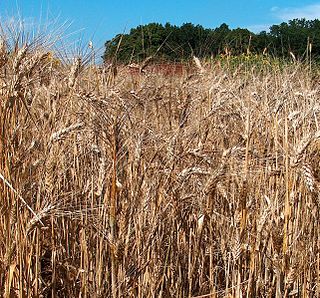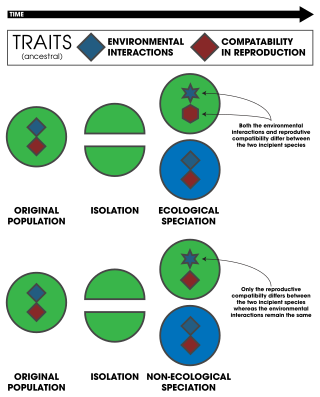
Arabidopsis (rockcress) is a genus in the family Brassicaceae. They are small flowering plants related to cabbage and mustard. This genus is of great interest since it contains thale cress, one of the model organisms used for studying plant biology and the first plant to have its entire genome sequenced. Changes in thale cress are easily observed, making it a very useful model.

Polyploidy is a condition in which the cells of an organism have more than one pair of (homologous) chromosomes. Most species whose cells have nuclei (eukaryotes) are diploid, meaning they have two complete sets of chromosomes, one from each of two parents; each set contains the same number of chromosomes, and the chromosomes are joined in pairs of homologous chromosomes. However, some organisms are polyploid. Polyploidy is especially common in plants. Most eukaryotes have diploid somatic cells, but produce haploid gametes by meiosis. A monoploid has only one set of chromosomes, and the term is usually only applied to cells or organisms that are normally diploid. Males of bees and other Hymenoptera, for example, are monoploid. Unlike animals, plants and multicellular algae have life cycles with two alternating multicellular generations. The gametophyte generation is haploid, and produces gametes by mitosis; the sporophyte generation is diploid and produces spores by meiosis.

Durum wheat, also called pasta wheat or macaroni wheat, is a tetraploid species of wheat. It is the second most cultivated species of wheat after common wheat, although it represents only 5% to 8% of global wheat production. It was developed by artificial selection of the domesticated emmer wheat strains formerly grown in Central Europe and the Near East around 7000 BC, which developed a naked, free-threshing form. Like emmer, durum wheat is awned. It is the predominant wheat that grows in the Middle East.

Self-pollination is a form of pollination in which pollen from the same plant arrives at the stigma of a flower or at the ovule. There are two types of self-pollination: in autogamy, pollen is transferred to the stigma of the same flower; in geitonogamy, pollen is transferred from the anther of one flower to the stigma of another flower on the same flowering plant, or from microsporangium to ovule within a single (monoecious) gymnosperm. Some plants have mechanisms that ensure autogamy, such as flowers that do not open (cleistogamy), or stamens that move to come into contact with the stigma. The term selfing that is often used as a synonym, is not limited to self-pollination, but also applies to other type of self-fertilization.
In population genetics and population ecology, population size is a countable quantity representing the number of individual organisms in a population. Population size is directly associated with amount of genetic drift, and is the underlying cause of effects like population bottlenecks and the founder effect. Genetic drift is the major source of decrease of genetic diversity within populations which drives fixation and can potentially lead to speciation events.
Biological specificity is the tendency of a characteristic such as a behavior or a biochemical variation to occur in a particular species.

Population fragmentation is a form of population segregation. It is often caused by habitat fragmentation.

Psathyrostachys juncea is a species of grass known by the common name Russian wildrye. It was formerly classified as Elymus junceus. It is native to Russia and China, and has been introduced to other parts of the world, such as Canada and the United States. Psathyrostachys juncea is a great source of food for grazing animals, as it has high nutrition value in its dense basal leaves, even in the late summer and autumn seasons. This species can grow and prosper in many harsh environments, making it an ideal candidate for improvement as it can grow in areas were farming is difficult. This species is a drought-resistant forage plant and can survive during the cool seasons. It is also a cross-pollinator and is self-sterile. This means that P. juncea cannot self-fertilize; it must find another plant of the same species with which to exchange gametes. Self-sterilization increases the genetic diversity of a species.

Doriprismatica is a genus of sea slugs, dorid nudibranchs, shell-less marine gastropod mollusks in the family Chromodorididae.
In molecular biology mir-398 microRNA is a short RNA molecule. MicroRNAs function to regulate the expression levels of other genes by several mechanisms.

The Lamprophiidae are a family of snakes found throughout much of Africa, including the Seychelles. There are 89 species as of July 2022.
Principapillatus is a monospecific genus of velvet worm containing the single species Principapillatus hitoyensis. Males of this species have 26 to 29 pairs of legs, usually 27 or 28; females have 30 to 32, usually 30 or 31. This velvet worm is viviparous, with mothers supplying nourishment to their embryos through a placenta. This species was discovered in Costa Rica.

Creontiades dilutus, commonly known as the green mirid, is a member of the bug family Miridae. This insect is considered a "generalist" feeding on over 100 plant species, and is also a major economic pest on several important agricultural crops.

When speciation is not driven by divergent natural selection, it can be said to be nonecological, so as to distinguish it from the typical definition of ecological speciation: "It is useful to consider ecological speciation as its own form of species formation because it focuses on an explicit mechanism of speciation: namely divergent natural selection. There are numerous ways other than via divergent natural selection in which populations might become genetically differentiated and reproductively isolated." It is likely that many instances of nonecological speciation are allopatric, especially when the organisms in question are poor dispersers, however sympatric nonecological speciation may also be possible, especially when accompanied by an "instant" loss of reproductive compatibility, as when polyploidization happens. Other potential mechanisms for nonecological speciation include mutation-order speciation and changes in chirality in gastropods.

Monoecy is a sexual system in seed plants where separate male and female cones or flowers are present on the same plant. It is a monomorphic sexual system comparable with gynomonoecy, andromonoecy and trimonoecy, and contrasted with dioecy where individual plants produce cones or flowers of only one sex.

Tatiana Rynearson is an American oceanographer who is a professor at the University of Rhode Island. Her research considers plankton diversity and abundance. Rynearson has been on several research cruises, including trips to the North Sea, Puget Sound, the Gulf of Mexico and the North Atlantic.
Mehely's blind mole-rat is an endangered species of rodent in the family Spalacidae. It is endemic to Romania.
Cardamine barbaraeoides is a perennial herbaceous plant in the Brassicaceae (mustard) family that is stenoendemic to the Southern Pindos mountains in Greece.

Silene amoena is a species of flowering plant in the family Caryophyllaceae, native to European Russia, Siberia, Central Asia, the western Himalayas, and Mongolia. A perennial, it is typically found in the subalpine or subarctic biomes. It has been characterized as either a diploid or a tetraploid and is a far eastern representative of section Auriculatae.













